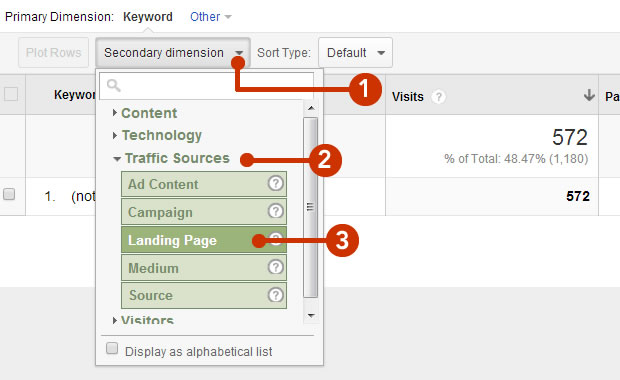Step-by-Step Overview: Leveraging Secondary Dimension in Google Analytics
Optimize Reporting Accuracy With Secondary Dimension in Google Analytics
Recognizing just how to maximize reporting precision with second dimensions in Google Analytics can significantly enhance the depth of insights originated from information analysis. By incorporating secondary measurements purposefully, marketers can reveal concealed patterns and relationships that might not be quickly evident when assessing primary metrics alone. This nuanced method makes it possible for a much more comprehensive understanding of customer actions and campaign efficiency, leading the way for more targeted and effective decision-making. The usage of second dimensions holds the essential to unlocking a wealth of beneficial details that can transform the performance of electronic advertising strategies.
Comprehending Second Dimensions in Google Analytics
To improve data evaluation and gain deeper insights into user habits, recognizing additional dimensions in Google Analytics is necessary. Second measurements enable individuals to section and better explore information beyond the primary measurement selected. By including second dimensions, experts can fine-tune their reports to expose even more thorough info concerning customer interactions on an internet site. While the key measurement may show the complete number of page sights, adding an additional measurement such as 'source/medium' can give understandings into where the web traffic originated from. This additional layer of details allows marketers to assess the performance of different marketing projects or channels in driving traffic to the web site.
Moreover, understanding secondary dimensions is crucial for developing much more personalized records customized to particular business goals. By choosing the right mix of second and main dimensions, analysts can reveal patterns, trends, and correlations that could otherwise continue to be hidden. This nuanced strategy to data evaluation equips businesses to make educated choices based on a detailed understanding of customer habits throughout numerous dimensions.

How to Use Additional Dimensions
When leveraging additional measurements in Google Analytics, the sensible application includes picking details information parameters to additional refine insights past the main dimension's scope. To apply secondary measurements successfully, begin by accessing the report or dataset where you desire to delve much deeper right into the data. Keep in mind that second measurements aid supply context and granularity to your key dimension information, enabling you to remove even more actionable and meaningful understandings from your Google Analytics records.
Leveraging Second Dimensions for Insights
Making use of secondary dimensions in Google Analytics permits for a much more detailed analysis of data, supplying valuable insights beyond the primary dimension's range. By leveraging additional measurements, individuals can dive deeper right into the performance metrics of their web site or app, discovering surprise patterns and trends that may not be quickly evident when only looking at primary dimensions.
One trick benefit of making use of second dimensions is the here capacity to section and filter information more specifically. This can aid online marketers and experts better comprehend the behavior of details user sections, such as new site visitors versus returning site visitors, or traffic originating from different geographic places.
In addition, second dimensions allow individuals to contrast and comparison different data points within the same record, providing a much more all natural view of efficiency (Secondary Dimension in Google Analytics). For instance, combining the main dimension of touchdown web pages with second dimensions like devices or demographics can disclose which web pages are most efficient in engaging customers on different gadgets or from different demographic groups.
Fundamentally, leveraging additional measurements in Google Analytics equips customers to draw out richer understandings from their data, leading to more informed decision-making and eventually, enhanced efficiency.
Finest Practices for Additional Dimensions
When analyzing data in Google Analytics, incorporating second measurements properly enhances the depth of insights Read Full Report stemmed from the main metrics. To make the most out of secondary measurements, it is crucial to abide by best practices that ensure significant and accurate coverage. It is essential to pick secondary dimensions that straighten with the main statistics you are evaluating. Choosing appropriate second dimensions helps in supplying context and a more clear understanding of the information being analyzed.
Moreover, it is recommended to restrict the number of additional measurements used in a single report to prevent frustrating the analysis with way too much details. Concentrating on a few crucial secondary measurements at a time can bring about even more focused and workable understandings. Furthermore, think about trying out different mixes of main and second measurements to uncover special fads and patterns that may not be obvious when checking out the information in isolation.
Advanced Analysis Techniques With Additional Measurements
Checking out detailed information connections with the strategic application of second measurements can introduce nuanced understandings that raise the depth of analysis in Google Analytics. By incorporating second dimensions with key information collections, innovative evaluation strategies can be utilized to draw out important info.
Moreover, secondary measurements can enhance the evaluation of conversion courses by click to find out more providing additional context. Comprehending the various touchpoints a user communicates with before converting can be essential in maximizing the customer journey - Secondary Dimension in Google Analytics. By making use of secondary dimensions to explore specifics such as web traffic sources or devices made use of, marketers can customize strategies to target high-converting networks properly
Final Thought

To boost information evaluation and gain much deeper insights right into customer actions, understanding second dimensions in Google Analytics is important - Secondary Dimension in Google Analytics. Additional measurements allow users to sector and even more explore data past the main dimension picked. While the main dimension might present the total number of web page sights, including a secondary measurement such as 'source/medium' can supply understandings into where the web traffic originated from.When leveraging secondary measurements in Google Analytics, the practical application includes choosing specific information criteria to more refine insights beyond the primary measurement's scope. Keep in mind that additional dimensions help provide context and granularity to your key dimension data, allowing you to remove even more workable and meaningful understandings from your Google Analytics records